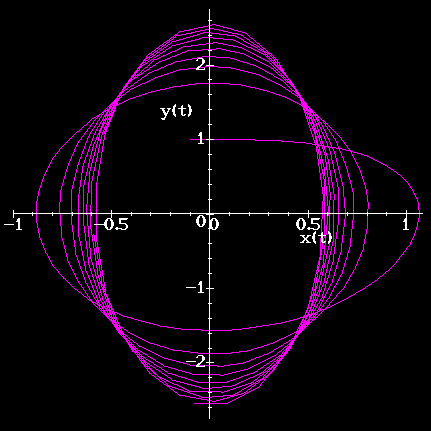![[Shownotes]](../gif/annotate/sshow-11.gif)


one example of a second-order equation like (1). (Producing such plots do not require advanced numerical software; they can be done with a simple graphing calculator.)


Figure 1: Graphs of solutions to the Airy equation with  and
and  .
.



The graphs in Figure 1
raises several questions about the long-term
behavior of such solutions. In fact, the analytical solution of Airy's
equation using Bessel functions (via Maple or Mathematica)
gives students
no further insight into the actual behavior of the solutions than the
original differential equation, unless they happen to know something
about Bessel functions
and  functions.
functions.
Physically, Airy's equation can be thought of as modeling a
spring, vibrating with no damping but with increasing spring
constant t > 0 (e.g., a spring vibrating in a rapidly chilling
room). As  , would you expect the spring to vibrate more
rapidly, with decreasing amplitude, as the xt graph in
Figure 1
indicates? Examining Figure 1 might lead students
to ask the following questions.
, would you expect the spring to vibrate more
rapidly, with decreasing amplitude, as the xt graph in
Figure 1
indicates? Examining Figure 1 might lead students
to ask the following questions.
Question 1.
What is the behavior of the solutions to Airy's equation as t becomes
large? Does the amplitude of the vibrations decrease toward zero with
time, or is it heading toward some other limiting amplitude? The
spacing of the zeros of the function appears to be decreasing with time,
i.e., the oscillations become more compressed. Does the spacing
between adjacent zeros approach 0 as  ?
?
Question 2.
What types of solutions exist for t < 0? What happens for negative
t that is not pictured in
Figure 1?
Are there any oscillatory
solutions? Are any solutions bounded? For a given value of  , is
there a unique bounded solution?
The asymptotic behavior of the solutions of Airy's equation is
known [1], but the methods traditionally used require some serious
complex analysis and are usually reserved for a graduate course in
applied mathematics.
, is
there a unique bounded solution?
The asymptotic behavior of the solutions of Airy's equation is
known [1], but the methods traditionally used require some serious
complex analysis and are usually reserved for a graduate course in
applied mathematics.